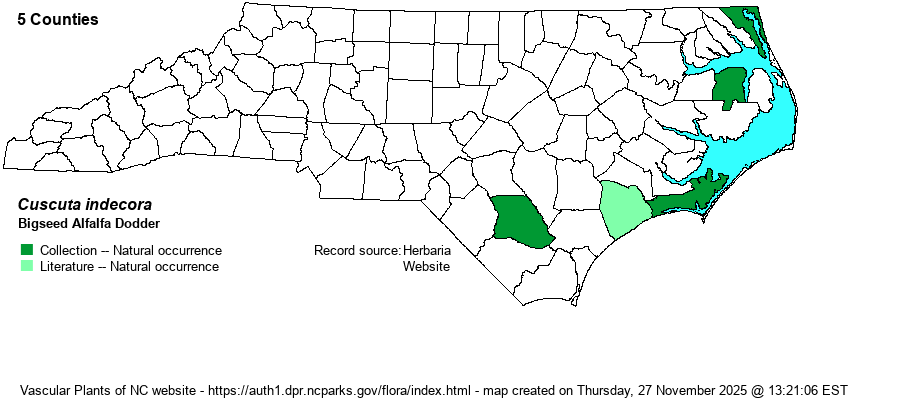| Author | Choisy | |
| Distribution | Mainly limited to coastal regions, though there is an inland specimen from Bladen County. So far known only from the Coastal Plain. A photo record on iNaturalist from Onslow County is Research Grade as the record seems to fit the expected range.
This is a poorly known species with a wide range. It occurs from NJ and ID south to southern FL and CA, and farther southward into the tropics. | |
| Abundance | Rare in coastal areas, and very rare elsewhere in the Coastal Plain. The NCNHP database, oddly, does not contain this species, even though it has been known from the state for many years. The website editors thus give a State Rank of S1? and a status of Watch List. | |
| Habitat | The species is found mainly around salt or brackish marshes, but also in other sunny wetlands near the coast, including roadsides. It also occurs in wet disturbed areas. It grows on many herbaceous and woody species across its wide range. | |
| Phenology | Blooms from July to October, and fruits shortly after flowering. | |
| Identification | See Taxonomic Comments. The description from Gleason (1952): "Flowers whitish, 3-5 mm. long, short-pediceled in loose irregular clusters. Calyx-lobes triangular, acute or subacute, shorter than to about equaling the broad corolla-tube. Corolla-lobes broadly triangular, erect or ascending, usually shorter than the tube, acute with inflexed tips." | |
| Taxonomic Comments | Weakley (2024) lists three varieties for this species -- attenuata, indecora, and longisepala. Owing to difficulty in keying out species, much less varieties within a species, the website is not including these varieties. See Weakley (2024) for more information. The species is not included in RAB (1968), perhaps as all collections have come since that publication date.
The species of Cuscuta all share a few similar features, and they are difficult to separate except by mostly small characters, best seen with a hand lens or microscope. Each is a parasitic vine, lacking roots or true leaves, and nearly all are orange or yellow in color, twining up its host plant with the use of tiny aerial "roots". The small white flowers are in clusters along the stem. These plants should be quite familiar as a group, often presenting a tangled mass of orange vines growing over other plants. See Weakley (2018) or other references for keys to assist in identification. | |
| Other Common Name(s) | Pretty Dodder, Collared Dodder | |
| State Rank | [S1?] | |
| Global Rank | G5 | |
| State Status | [W7] | |
| US Status | | |
| USACE-agcp | | |
| USACE-emp | | |

